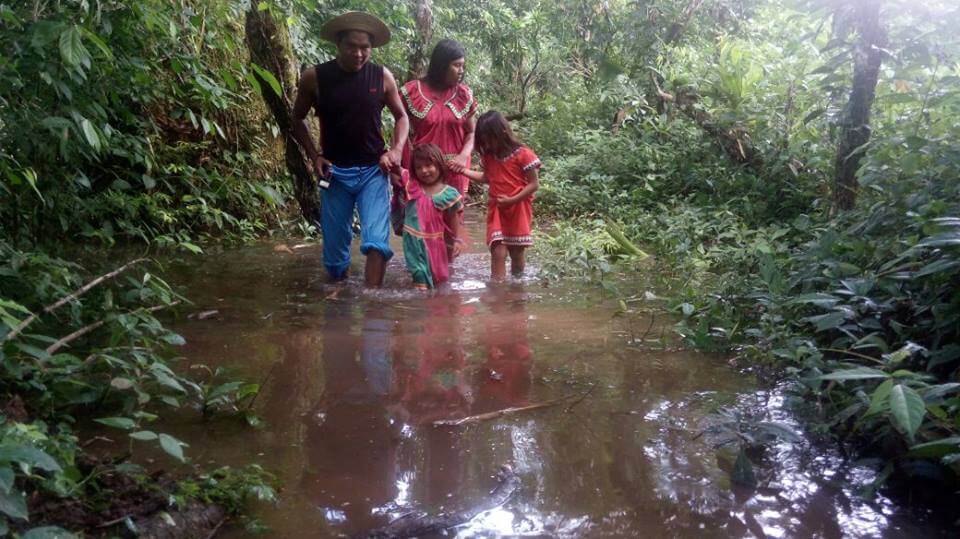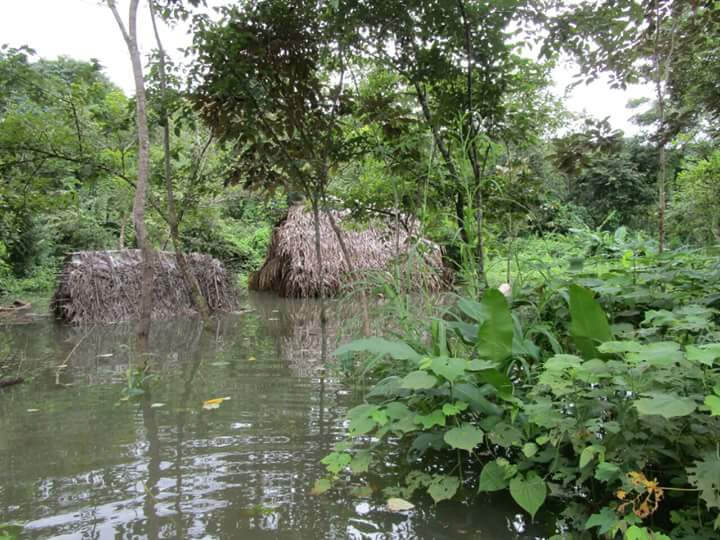Indigenous Ngäbe communities living on the banks of the Tabasará River in western Panama are scrambling for their lives as flood water from the Barro Blanco hydroelectric reservoir inundates their houses, schools, farms and cultural centers.
“We are without homes and without anywhere to take shelter,” said Weni Bagama in a video statement recorded on Wednesday, Aug 24, 2016.
Bagama—a lifelong resident of the community of Kiad—explained that local road connections have been washed away by the flood waters leaving her family and neighbors geographically isolated. A group of springs that the community relied upon for safe drinking water have also been lost along with archaeological sites of local and national significance.

Roads into Kiad are now under water and the community is inaccessible. Photo: Ricardo Miranda
Two days before Bagama’s statement, Panama President Juan Carlos Varela was busy celebrating the signing of a formal “peace agreement” between his government and Silvia Carrera, the elected chief of the semi-autonomous Comarca Ngäbe-Buglé.
The signing took place in the Ngäbe town of Llano Tugri where some 80 police officers clashed with a handful of angry protesters.
“After 19 months of dialogue we seal the deal that ends the conflict over the Barro Blanco Hydroelectric project,” wrote President Varela on his Facebook page without the slightest hint of irony.
“With the signing of this agreement we have achieved clear objectives for the benefit of the Ngäbe people.”
His Facebook post includes a self-congratulatory public relations video and a link to a full press statement asserting that “the success was achieved on the basis of respect, tolerance and a thorough examination of the key aspects of the project.”
Despite President Verala’s claims, however, none of the Tabasará communities directly affected by the flood waters were involved in the talks. Nor did they endorse the new agreement.
Since the project’s inception in 2011, the affected communities have maintained vigorous opposition to the Barro Blanco dam.

Submerged houses. Photo: Ricardo Miranda
What’s more, according to Bagama, the flooding of their communities commenced on Friday, Aug. 19, 2016 – a full three days before the signing in Llano Tugri. Furthermore, by Saturday—some 48 hours before the ill-fated PR fiasco—the inundation had already completely destroyed the community of Quebrada Caña.
“The population who lived there had to collect their things and see what they could salvage,” she said.
President Varela’s pronouncement seems to be the latest move in what human rights lawyer Osvaldo Jordan calls “a game of words”—that is, a cynical and carefully planned PR campaign designed to obfuscate gross human rights violations.
“The agreement does not seem to have any legal basis,” he told IC. “However, many people seem to believe in it and have forgotten the most important story: the communities being flooded illegally before the agreement was signed.”
In fact, the flooding of the Tabasará River basin began last May with what the government cunningly described as a “test filling”. The reservoir was allowed to rise to a height of 87.5 meters and remained stable until last Friday when the green light was given to let it rise higher and flood the communities.
Disturbingly, according to evidence presented in an independent report by the Human Rights Network of Panama (HRNP), the so-called “test-filling” was achieved not through “respectful dialogue” but through violence and thuggery.
According to eye-witness testimonies, on May 23 2016, police invaded a long-standing indigenous Ngäbe protest camp on the banks of the river, assaulted and humiliated the assembled families, confiscated their possessions, demolished their church, and killed and mutilated their animals.
Said one anonymous witness:
“While we [were] praying in the church, and in the presence of various pastors visiting from other regions, a heap of people arrived from the company, the police, SINAPROC, and they told us that we would have to leave there because it was the property of the company and it was to be flooded.”
“They told us that there was an eviction order–that we would have to die if we would not move. We continued praying and then they pulled us away and started to break up and tear down the houses. They killed the dogs, chickens, pigs, and even the parrots that we had. They grabbed the children and women and carried them to the bus. There were many against us and some ran away. One companion was stripped naked in front of her children and husband…”
Some 30 Ngäbe protesters were rounded up that day and transported to the nearby town of Tolé where they were detained for approximately 36 hours without due process.
Police confined the protesters to Tolé’s Catholic Mission Center and reportedly failed to explain to the priests exactly what had occurred. In fact, none of the detainees were formally charged or permitted to seek legal support. Some of them alleged injuries to their legs and arms, but no medical care was dispatched.
While the protesters spent a gloomy night incarcerated in the Mission, Panama’s civil protection services distributed sacks of rice and other sundry ‘gifts’ to nearby communities not directly impacted by the dam in an apparent effort to create further division between the communities.
The next day, at around 11:00am, without any regard for domestic protocols or international human rights law, Generadora del Istmo (GENISA) closed the gates on their 29 MW hydroelectric dam and commenced flooding the Tabasará River basin. As the water levels rose, farm plots were washed away and witnesses reported a massive fish die-off.

The formation of the reservoir saw endemic fish die. Photo: Chiriquí Natural
Any hopes that GENISA would soon conclude their “tests” and reopen the gates were definitively crushed when the company met with their financial backers and the Government of Panama on July 8 2016.
Owned and built by the Kafie family (who are currently embroiled in a massive fraud scandal in their home country of Honduras), Barro Blanco is being financed primarily by European taxpayers via the Dutch Entrepreneurial Development Bank (FMO) and the German Development Bank (DEG), along with the Central American Bank for Economic Integration (CABEI).
In a press release on the FMO’s website, CEO Nanno Keiterp commented:
“It was important to have for the first time a tripartite meeting [in Panama City], which allowed the Government and Genisa to exchange feasible options for the continuation of the project… FMO and the other lenders will continue to support this process.”
The statement went on to applaud the project for its “benefits to the local communities”.
Indeed, the political pressure to maintain a “positive” environment for foreign investors—that is, one presumably devoid of human rights or environmental obligations – may have been the force driving Varela’s latest PR stunt.
“He did it to stay on good terms with the corporate lawyers in his entourage and foreign embassies, including the US one”, said Eric Jackson, editor of the Panama News. “Think about the dam business as a whole. Varela is threatening more of these projects, with offsetting promises that are empty.”
For what it’s worth, the agreement between the government and Carrera does include promises of significant investment in Ngabe communities, particularly those living in Muna District near the project.
That’s not saying much, however, as the document has been roundly rejected by GENISA, the Tasabará communities, and even Panama’s own National Assembly. In any case, promises of long overdue regional investment will be cold comfort to those communities experiencing the flagrant violation of their human rights, not to mention the destruction of their homes.
One elder from Kiad told HRNP:
“Those people do not understand that I cannot sell this sacred land. I need my land, I will not sell my land, the land is not like money. Money gets wet, it rots, melts and ends; the land, no, it is permanent, not for sale. Money is deception… What price do the ants have? The stones? The crickets? The trees? The water? I cannot put a price on it, it is the heritage of my children. Without this land we die.”
There is some hope that the national ombudsman may be able to interrupt the violations currently taking place on the Tabasará River. However, with national and international media turning a blind eye to these events, that hope appears tenuous at best.

Indigenous Peoples are putting their bodies on the line and it's our responsibility to make sure you know why. That takes time, expertise and resources - and we're up against a constant tide of misinformation and distorted coverage. By supporting IC you're empowering the kind of journalism we need, at the moment we need it most.